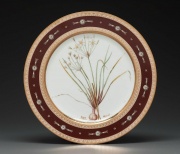Difference between revisions of "Hard paste porcelain"
Jump to navigation
Jump to search
m (Text replace - "\[http:\/\/cameo\.mfa\.org\/materials\/fullrecord\.asp\?name=([^\s]+)\s(.*)\]" to "$2") |
|||
| (One intermediate revision by the same user not shown) | |||
| Line 2: | Line 2: | ||
== Description == | == Description == | ||
| − | True, translucent [[porcelain]] which has been fired at temperatures of about 1400C. Hard paste porcelain is composed of [ | + | True, translucent [[porcelain]] which has been fired at temperatures of about 1400C. Hard paste porcelain is composed of [[kaolin|kaolin]], [[feldspar]], [[quartz]], and/or [[flint]]. Hard paste porcelains were made in China and Japan in the 5th century CE from naturally occurring mixtures of clay. The first man-made mixture of hard paste was developed in Meissen, Germany in 1710. Soft paste porcelains are fired at lower temperatures. |
[[File:2001.247-SC58341.jpg|thumb|]] | [[File:2001.247-SC58341.jpg|thumb|]] | ||
| Line 10: | Line 10: | ||
pate dure; hard-paste; hardpaste; porcelaine à pâte dure (Fr.); porcelana de pasta dura (Port.) | pate dure; hard-paste; hardpaste; porcelaine à pâte dure (Fr.); porcelana de pasta dura (Port.) | ||
| − | == | + | == Sources Checked for Data in Record == |
* Henry Hodges, ''Artifacts: An Introduction to Early Materials and Technology'', Ronald P. Frye, Kingston, Canada, 1988 | * Henry Hodges, ''Artifacts: An Introduction to Early Materials and Technology'', Ronald P. Frye, Kingston, Canada, 1988 | ||
Revision as of 13:05, 9 May 2016
Description
True, translucent Porcelain which has been fired at temperatures of about 1400C. Hard paste porcelain is composed of Kaolin, Feldspar, Quartz, and/or Flint. Hard paste porcelains were made in China and Japan in the 5th century CE from naturally occurring mixtures of clay. The first man-made mixture of hard paste was developed in Meissen, Germany in 1710. Soft paste porcelains are fired at lower temperatures.
Synonyms and Related Terms
pate dure; hard-paste; hardpaste; porcelaine à pâte dure (Fr.); porcelana de pasta dura (Port.)
Sources Checked for Data in Record
- Henry Hodges, Artifacts: An Introduction to Early Materials and Technology, Ronald P. Frye, Kingston, Canada, 1988
- Robert Fournier, Illustrated Dictionary of Practical Pottery, Chilton Book Company, Radnor, PA, 1992
- The Dictionary of Art, Grove's Dictionaries Inc., New York, 1996 Comment: "Ceramics";
- Ralph Mayer, A Dictionary of Art Terms and Techniques, Harper and Row Publishers, New York, 1969 (also 1945 printing)
- Random House, Webster's Encyclopedic Unabridged Dictionary of the English Language, Grammercy Book, New York, 1997
- Art and Architecture Thesaurus Online, http://www.getty.edu/research/tools/vocabulary/aat/, J. Paul Getty Trust, Los Angeles, 2000

